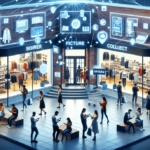How O2O Is Shaping the Future of Ecommerce
Online-to-offline (O2O) is revolutionizing the ecommerce landscape by seamlessly integrating online and offline shopping experiences. This innovative approach enhances customer satisfaction by leveraging the strengths of both channels. In this article, we explore the concept of O2O, its benefits and challenges, and its transformative impact on the ecommerce industry.
What is O2O and Why is It Important for Ecommerce?
O2O is a business model that connects online and offline shopping experiences, allowing businesses to harness the advantages of both platforms. This integration enables customers to enjoy the convenience of online shopping while benefiting from the immediate gratification and tactile experience of physical stores. By offering a personalized and seamless shopping journey, businesses can better meet the evolving preferences and behaviors of their customers.
One significant advantage of O2O is the ability to unify online and offline marketing efforts. Utilizing data from online interactions, businesses can craft targeted marketing campaigns that drive traffic to physical stores. Conversely, in-store promotions can encourage customers to engage with online platforms. This synergy enhances brand visibility, fosters customer loyalty, and ultimately boosts sales.
Bridging Online and Offline Shopping Experiences
Key Services Facilitating O2O Integration
- Click-and-Collect: Allows customers to purchase products online and pick them up in-store.
- Same-Day Delivery: Provides customers with the option to receive their purchases rapidly.
- In-Store Pick-Up: Enables customers to collect items ordered online directly from the store.
These services enhance customer satisfaction by offering flexibility and convenience, while streamlining business operations.
Data-Driven Insights
O2O strategies empower businesses to gather comprehensive data on customer behaviors and preferences. By analyzing interactions across both channels, companies can identify popular products, assess the effectiveness of marketing campaigns, and understand shopping patterns. This data-driven approach allows for the optimization of business strategies and the improvement of the overall customer experience.
Expanding Customer Reach
O2O enables businesses to attract a broader customer base by combining online accessibility with physical presence. Online services like digital marketing can draw in customers who may not have discovered the brand otherwise. O2O features such as in-store pick-up encourage repeat purchases and foster customer loyalty.
The Impact of O2O on Traditional Brick-and-Mortar Retail Stores
The rise of ecommerce has significantly influenced traditional brick-and-mortar stores. O2O offers these businesses the opportunity to incorporate digital technologies into their physical operations, creating a unified shopping experience.
Enhanced Customer Insights
By tracking both online and offline interactions, traditional retailers can gain valuable insights into customer preferences. This information can be used to tailor marketing strategies, optimize store layouts, and refine product offerings, thereby enhancing the shopping experience.
Challenges in Implementing O2O
Adopting O2O strategies presents several challenges for traditional retailers, including:
- Technological Investment: Significant resources are required to develop and maintain digital platforms.
- Staff Training: Employees need to be trained to handle new technologies and customer interactions.
- Market Competition: Competing with established ecommerce players can be daunting for brick-and-mortar stores.
Increasing Customer Engagement and Loyalty Through O2O
O2O strategies can significantly boost customer engagement and loyalty by offering a personalized and convenient shopping experience.
Personalized Recommendations and Loyalty Programs
Features such as personalized product recommendations and loyalty rewards programs encourage customers to interact more frequently with the brand. Seamless payment options further enhance the shopping experience, fostering a loyal customer base.
In-Store Promotions for Online Customers
Offering exclusive in-store promotions and discounts to online customers incentivizes them to visit physical stores, increasing sales and deepening their connection with the brand.
The Role of Mobile Devices in Enabling O2O Transactions
Mobile devices are pivotal in facilitating O2O transactions by acting as a bridge between online and offline channels.
Mobile Integration
Mobile apps and responsive websites allow customers to interact with businesses on-the-go, making purchases, claiming offers, and tracking loyalty rewards with ease.
Data Collection and Personalization
Mobile devices enable businesses to collect detailed data on customer behavior, including location, search history, and purchase patterns. This information is crucial for personalizing marketing strategies and improving the customer experience.
Convenience and Real-Time Updates
The convenience of mobile transactions—such as ordering, payment, and delivery tracking—enhances the customer experience by saving time and providing real-time updates on order status.
Successful O2O Strategies Implemented by Ecommerce Businesses
Numerous ecommerce businesses have effectively implemented O2O strategies to enhance customer engagement and drive sales.
Click-and-Collect Services
Businesses like Nike offer click-and-collect services, allowing customers to purchase online and pick up products in-store, thereby increasing store traffic and sales.
Same-Day Delivery
Companies such as Walmart provide same-day delivery options, competing with ecommerce giants like Amazon and expanding their market share.
Pop-Up Stores
Temporary pop-up stores enable ecommerce brands to offer physical experiences, collect customer data, and receive direct feedback, enhancing their overall strategy.
Collaborations with Brick-and-Mortar Stores
Partnerships between ecommerce platforms and physical retailers offer exclusive discounts and promotions, driving foot traffic and increasing sales for both parties.
Overcoming Challenges in Implementing O2O Strategies
While O2O offers numerous benefits, businesses must navigate several challenges to implement these strategies successfully.
Robust Infrastructure
Businesses need a reliable ecommerce platform, functional mobile applications, and an efficient supply chain to support O2O operations. Additionally, well-trained staff are essential for handling in-store transactions and providing excellent customer service.
Seamless Integration of Channels
Integrating online and offline channels requires a deep understanding of customer behavior and advanced analytics tools to track and analyze data across various touchpoints.
Adaptability to Market Changes
O2O strategies demand flexibility and agility, enabling businesses to respond swiftly to changing market conditions and customer preferences. Fostering a culture of innovation and willingness to experiment is crucial for ongoing success.
Future Trends in O2O and Its Impact on Ecommerce
The future of O2O in ecommerce is poised for significant growth, driven by advancements in technology and evolving consumer expectations.
Integration of Advanced Technologies
Emerging technologies such as artificial intelligence (AI), machine learning, and augmented reality (AR) will enhance personalized shopping experiences and provide immersive interactions for customers. Additionally, integrating O2O with blockchain and the Internet of Things (IoT) will open new avenues for operational efficiency and customer engagement.
Social Commerce
Social media platforms are becoming crucial in driving O2O conversions. Businesses are leveraging these channels to promote products and encourage physical store visits, creating a cohesive shopping journey from discovery to purchase.
Case Studies of Successful O2O Implementations
Several businesses have effectively utilized O2O strategies to drive sales and revenue growth.
Starbucks
Starbucks has integrated mobile ordering and in-store pick-up, enhancing the customer experience and increasing store traffic. This approach has significantly boosted sales and fostered customer loyalty.
Walmart
Walmart's implementation of same-day delivery and in-store pickup has enabled the company to compete with ecommerce giants like Amazon, expanding their market share and increasing revenue.
Nike
Nike offers online reservations for in-store product pick-up and has incorporated augmented reality technology in stores, allowing customers to virtually try on shoes. These innovations have improved sales and provided a unique, interactive shopping experience.
Conclusion
O2O is a transformative concept in the ecommerce industry, bridging the gap between online and offline shopping to deliver a seamless and personalized customer experience. By leveraging O2O strategies, businesses can enhance customer engagement, increase loyalty, and drive sales. However, successful implementation requires overcoming challenges related to infrastructure, integration, and adaptability. As O2O continues to evolve with emerging technologies, its impact on the future of retail will become increasingly profound.




















